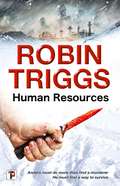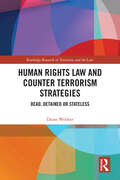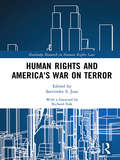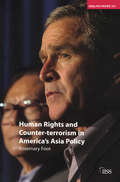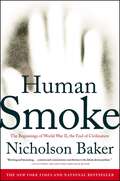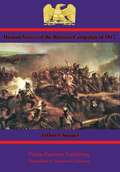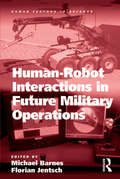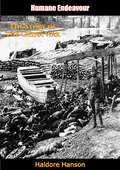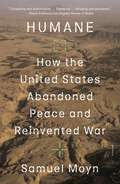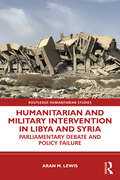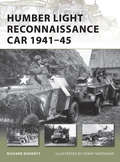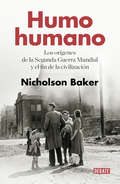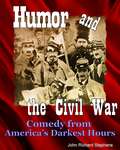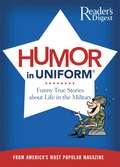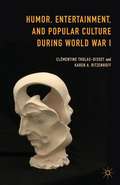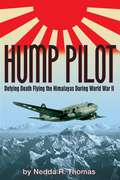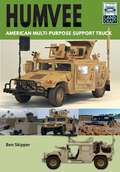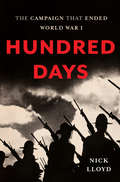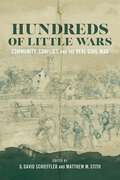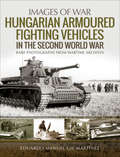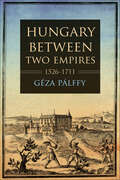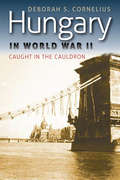- Table View
- List View
Human Resources (Fiction Without Frontiers)
by Robin TriggsThe sequel to Night Shift, praised by Crime Review and Cemetery Dance.Antarctica. A city on the edge of nowhere.Anders Nordvelt is chief of security in this frozen land, so, when a prominent member of a dissident group is murdered, it is his job to find the killer. Unsatisfied with the obvious explanation, Anders keeps pushing until the body of a colleague turns up in his apartment. Could Anders really be the killer? Why does he half-remember wielding the knife? And why are the whispers of a fabled Human Resources black-ops team getting ever louder?As for Anders, he&’s about to enter a deadly game of cat-and-mouse with a ruthless killer.FLAME TREE PRESS is the new fiction imprint of Flame Tree Publishing. Launched in 2018 the list brings together brilliant new authors and the more established; the award winners, and exciting, original voices.
Human Rights Law and Counter Terrorism Strategies: Dead, Detained or Stateless (Routledge Research in Terrorism and the Law)
by Diane WebberIn 2006, the United Nations urged Member States to ensure that counter terrorism policies guaranteed respect for human rights and the rule of law. This book demonstrates that, in many cases, counter terrorism policies relating to preventive detention, targeted killing and measures relating to returning foreign terrorist fighters have failed to respect human rights, and this encourages vulnerable people to be drawn towards supporting or committing acts of terrorism. Furthermore, in recent years, jurisprudence and public opinion in some countries have shifted from being at one stage more protective of human rights, to an acquiescence that some particularly draconian counter terrorism methods are necessary and acceptable. This book analyzes why this has happened, with a focus on the United States, United Kingdom, and Israel, and offers suggestions to address this issue. The work will be essential reading for students, academics and policy-makers working in the areas of human rights, humanitarian law, and counter terrorism.
Human Rights and America's War on Terror (Routledge Research in Human Rights Law)
by Satvinder S. JussThis volume examines the success of the 9/11 attacks in undermining the cherished principles of Western democracy, free speech and tolerance, which were central to US values. It is argued that this has led to the USA fighting disastrous wars in Afghanistan and Iraq, and to sanctioning the use of torture and imprisonment without trial in Guantánamo Bay, extraordinary rendition, surveillance and drone attacks. At home, it has resulted in restrictions of civil liberties and the growth of an ill-affordable military and security apparatus. In this collection the authors note the irony that the shocking destruction of the World Trade Center on 9/11 should become the justification for the relentless expansion of security agencies. Yet, this is a salutary illustration of how the security agencies in the USA have adopted faulty preconceptions, which have become too embedded within the institution to be abandoned without loss of credibility and prestige. The book presents a timely assessment of both the human rights costs of the ‘war on terror’ and the methods used to wage and relentlessly continue that war. It will be of interest to researchers, academics, practitioners and students in the fields of human rights law, criminal justice, criminology, politics and international studies.
Human Rights and Counter-terrorism in America's Asia Policy (Adelphi series)
by Rosemary FootThis book examines the effects of the terrorist attacks on New York and Washington of 11 September 2001 on America's human rights and counter-terrorism policies towards a number of countries in Asia. Five countries have been chosen for examination, divided into two front-lines states (Pakistan and Uzbekistan), two second-front countries (Indonesia and Malaysia), and a third-front country, China. The paper also looks at changes in US domestic legislation and its treatment of prisoners at Guantanamo Bay and elsewhere in order to analyse the extent to which the US promotion of an external human rights policy might also have been compromised by its own legislative changes as a result of the struggle against terrorism. The paper concludes that the attacks on US territory, overall, have constrained America's willingness and capacity to promote an external human rights policy with respect to these five countries. However, some attention - especially at the rhetorical level - to these countries' human rights records has been retained to differing degrees among the five states. This degree of difference is not explained entirely in reference to a country's perceived centrality to the struggle against terrorism. It depends on the extent to which the US executive and legislative branches are united - either singly or in combination - in their disapproval of a state's record, or in their understanding about how best to reach the policy goals that are sought.
Human Rights in Armed Conflict: Law, Practice, Policy
by Gerd OberleitnerIt is now widely accepted that international human rights law applies in situations of armed conflict alongside international humanitarian law, but the contours and consequences of this development remain unclear. This book revisits, organizes and contextualizes the debate on human rights in armed conflict and explores the legal challenges, operational consequences and policy implications of resorting to human rights in situations of inter- and intra-state violence. It presents the benefits and the drawbacks of using international human rights law alongside humanitarian law and discusses how the idea, law and policy of human rights influence the development of the law of armed conflict. Based on legal theory, policy analysis, state practice and the work of human rights bodies it suggests a human rights-oriented reading of the law of armed conflict as feasible and necessary in response to the changing character of war.
Human Smoke: The Beginnings of World War II, the End of Civilization
by Nicholson BakerBestselling author Nicholson Baker, recognized as one of the most dexterous and talented writers in America today, has created a compelling work of nonfiction bound to provoke discussion and controversy -- a wide-ranging, astonishingly fresh perspective on the political and social landscape that gave rise to World War II. Human Smoke delivers a closely textured, deeply moving indictment of the treasured myths that have romanticized much of the 1930s and '40s. Incorporating meticulous research and well-documented sources -- including newspaper and magazine articles, radio speeches, memoirs, and diaries -- the book juxtaposes hundreds of interrelated moments of decision, brutality, suffering, and mercy. Vivid glimpses of political leaders and their dissenters illuminate and examine the gradual, horrifying advance toward overt global war and Holocaust. Praised by critics and readers alike for his exquisitely observant eye and deft, inimitable prose, Baker has assembled a narrative within Human Smoke that unfolds gracefully, tragically, and persuasively. This is an unforgettable book that makes a profound impact on our perceptions of historical events and mourns the unthinkable loss humanity has borne at its own hand.
Human Voices of the Russian Campaign of 1812: a translation of “Etudes d’Histoire”
by Harriet M. Capes Arthur ChuquetThis ebook is purpose built and is proof-read and re-type set from the original to provide an outstanding experience of reflowing text for an ebook reader. Few French historians of the Revolutionary and Napoleonic period have the stature of Arthur Chuquet, his copious writings on the era are most penetrating and accurate. He was also a master of infusing them with a character of the men that shaped the age; this was possible only by his encyclopaedic knowledge of the memoirs and letters of the combatants, diplomats, generals of the European powers. In this translation of one of his volumes, he focusses on the experiences of the men of the Grande Armée as they march into Russia, a march that would cost so many of their lives. The vivid pictures drawn from the memoiralists are elucidated by Chuquet's notes and his tight incisive editing. Not a campaign history, but snapshots of the experiences of the high and low of the French and Allied forces; from Napoleon's aide-de-camp de Narbonne to lowly paymaster Guillaume Peyrusse. An excellent collection of memoirs. Title - Human Voices of the Russian Campaign of 1812 Sub-Title - translation of "Etudes d'Histoire" Author -- Arthur Chuquet (1853-1925) Translator -- Harriet M. Capes (???? - ????) Text taken, whole and complete, from the edition published in 1913, London, by Andrew Melrose. Original - 296 pages.
Human-Robot Interactions in Future Military Operations (Human Factors in Defence)
by Florian JentschSoldier-robot teams will be an important component of future battle spaces, creating a complex but potentially more survivable and effective combat force. The complexity of the battlefield of the future presents its own problems. The variety of robotic systems and the almost infinite number of possible military missions create a dilemma for researchers who wish to predict human-robot interactions (HRI) performance in future environments. Human-Robot Interactions in Future Military Operations provides an opportunity for scientists investigating military issues related to HRI to present their results cohesively within a single volume. The issues range from operators interacting with small ground robots and aerial vehicles to supervising large, near-autonomous vehicles capable of intelligent battlefield behaviors. The ability of the human to 'team' with intelligent unmanned systems in such environments is the focus of the volume. As such, chapters are written by recognized leaders within their disciplines and they discuss their research in the context of a broad-based approach. Therefore the book allows researchers from differing disciplines to be brought up to date on both theoretical and methodological issues surrounding human-robot interaction in military environments. The overall objective of this volume is to illuminate the challenges and potential solutions for military HRI through discussion of the many approaches that have been utilized in order to converge on a better understanding of this relatively complex concept. It should be noted that many of these issues will generalize to civilian applications as robotic technology matures. An important outcome is the focus on developing general human-robot teaming principles and guidelines to help both the human factors design and training community develop a better understanding of this nascent but revolutionary technology. Much of the research within the book is based on the Human Research and Engineering Directorate (HRED), U.S. Army Research Laboratory (ARL) 5-year Army Technology Objective (ATO) research program. The program addressed HRI and teaming for both aerial and ground robotic assets in conjunction with the U.S. Army Tank and Automotive Research and Development Center (TARDEC) and the Aviation and Missile Development Center (AMRDEC) The purpose of the program was to understand HRI issues in order to develop and evaluate technologies to improve HRI battlefield performance for Future Combat Systems (FCS). The work within this volume goes beyond the research results to encapsulate the ATO's findings and discuss them in a broader context in order to understand both their military and civilian implications. For this reason, scientists conducting related research have contributed additional chapters to widen the scope of the original research boundaries.
Humane Endeavour: The Story of the China War
by Haldore HansonAs a foreign correspondent in the 1930’s, Haldore Hanson covered the Chinese civil war and the invasion of China by Japan. Traveling rural roads on bicycle, he rotated among the warring forces and was occasionally arrested by one side or the other.The present volume, “Humane Endeavor”, which was first published in 1939, was praised as a rare close-up from the remote front lines. Owing to his expertise, the State Department hired him as an official in 1942. After World War II, he became assistant director of the Point Four development aid program for Asia.“A complete coverage of the war years, with pictures of outstanding personalities. [Hanson] reports on the fall of Peiping, on war on the Mongel front, on the sieges of Shanghai, Nanking, on Japanese atrocities, war in the air, finance and man power, Japanese rule in conquered areas, guerilla warfare, border republics, [and] experiences with the 8th Route Army. Interesting reading it holds the interest throughout, and has the vitality of a first-hand record.”—Kirkus Review
Humane: How the United States Abandoned Peace and Reinvented War
by Samuel MoynA prominent historian exposes the dark side of making war more humaneIn the years since 9/11, we have entered an age of endless war. With little debate or discussion, the United States carries out military operations around the globe. It hardly matters who’s president or whether liberals or conservatives operate the levers of power. The United States exercises dominion everywhere.In Humane: How the United States Abandoned Peace and Reinvented War, Samuel Moyn asks a troubling but urgent question: What if efforts to make war more ethical—to ban torture and limit civilian casualties—have only shored up the military enterprise and made it sturdier? To advance this case, Moyn looks back at a century and a half of passionate arguments about the ethics of using force. In the nineteenth century, the founders of the Red Cross struggled mightily to make war less lethal even as they acknowledged its inevitability. Leo Tolstoy prominently opposed their efforts, reasoning that war needed to be abolished, not reformed—and over the subsequent century, a popular movement to abolish war flourished on both sides of the Atlantic. Eventually, however, reformers shifted their attention from opposing the crime of war to opposing war crimes, with fateful consequences.The ramifications of this shift became apparent in the post-9/11 era. By that time, the US military had embraced the agenda of humane war, driven both by the availability of precision weaponry and the need to protect its image. The battle shifted from the streets to the courtroom, where the tactics of the war on terror were litigated but its foundational assumptions went without serious challenge. These trends only accelerated during the Obama and Trump presidencies. Even as the two administrations spoke of American power and morality in radically different tones, they ushered in the second decade of the “forever” war.Humane is the story of how America went off to fight and never came back, and how armed combat was transformed from an imperfect tool for resolving disputes into an integral component of the modern condition. As American wars have become more humane, they have also become endless. This provocative book argues that this development might not represent progress at all.
Humanitarian Logistics and Sustainability
by Matthias Klumpp Sander Leeuw Alberto Regattieri Robert SouzaThis contributed volume combines conceptual and strategic research articles dealing with the "why" and "to what end" of sustainable operations in humanitarian logistics, as well as operational research contributions regarding the "how" from the United Nations as well as from researchers and organizations from different countries (Germany, Australia, Singapore, Netherlands, Italy, Denmark, Jordan). The target audience primarily comprises research experts, decision makers and practitioners in the field, but the book may also be beneficial for graduate students.
Humanitarian and Military Intervention in Libya and Syria: Parliamentary Debate and Policy Failure (Routledge Humanitarian Studies)
by Aran M. LewisThis book explores the contradictions in Britain’s humanitarian and military intervention in Libya and Syria, beginning with the Arab spring in 2010. The book assesses the contradictions between the expressed humanitarian intentions of British military interveners and the impact of their actions on the putative beneficiary states. It demonstrates that, as a result of foreign intervention, both Libya and Syria were rendered non-functional as unitary nations and suffered extensive harm to their people and infrastructure. To evaluate the effectiveness and credibility of humanitarian warfare, the author conducts a thematic analysis of debates on Libya and Syria in the House of Commons. The book provides a detailed study of intentions and motives expressed by Members of Parliament, of consequent British state actions and their outcomes, and of MPs’ reactions to outcomes. It provides ample evidence of duplicity, insincerity, indifference to harm, and ulterior motives for violence that undermine moral claims and support the argument that, although humanitarian warfare may be possible, the leading Western activist states (Britain, France, and the USA) are poorly qualified to carry it out. Illustrating a systemic failure of strategy and accountability in British foreign policy, this book will be of interest to scholars and graduates of Humanitarian Studies, International Relations and Military Studies.
Humber Light Reconnaissance Car 1941-45
by Henry Morshead Richard DohertyThe iconic vehicle of the British Army's Reconnaissance Corps during World War II, the Humber Light Reconnaissance Car (LRC) saw service in several theatres of war between 1941 and 1945. The Humber LRC gave excellent service to the Reconnaissance Corps with its agility, speed and height proving to be invaluable assets to the units that operated it. Using numerous photographs, and newly commissioned artwork, this book looks at the development of the LRC, its use by the Reconnaissance Corps and its importance to British infantry divisions in the theater in which it served.
Humo humano: Los orígenes de la Segunda Guerra Mundial y el fin de la civilización
by Nicholson BakerUn libro inolvidable que tendrá un profundo efecto sobre nuestra visión de los acontecimientos históricos que culminaron en la Segunda Guerra Mundial y que contiene un sentido lamento por la irreparable pérdida que la humanidad se ha causado a sí misma. No es fácil aplicar una luz distinta a acontecimientos muy conocidos, pero eso es lo que logra Nicholson Baker en esta extraordinaria historia de los orígenes de la Segunda Guerra Mundial. A partir de fragmentos extraídos de periódicos y revistas de la época, discursos radiofónicos, panfletos, diarios y libros de memorias, entre otras fuentes, ordenados cronológicamente, Baker crea un mosaico de momentos decisivos, de barbarie, sufrimiento y compasión, de iluminadores destellos sobre escenas cotidianas e históricas. Una obra coral que, setenta años después, nos deja oír las voces de los líderes políticos y sus opositores, escritores, periodistas, militares y pacifistas, testimonios que ilustran de manera conmovedora el imparable y horrible avance hacia la guerra global y el holocausto. Elogiado por la crítica y los lectores por su capacidad de observación y su límpida prosa, Baker ha creado una narración que se desarrolla elegante, trágica y convincentemente. Reseñas:«Este libro absolutamente extraordinario -imposible de abandonar, imposible de olvidar- podría convertirse en el argumento más convincente en favor de la paz jamás construido. Este inventario meticulosamente seleccionado por Nicholson Baker muestra con asombroso y fascinante detalle el imparable descenso de la humanidad hacia la locura de la guerra.»Simon Winchester «Lentamente, a medida que lees, como consecuencia de la variedad en el tono y de la naturaleza trágica o terrible de la cita, así como de lo certero de su elección, Humo humano se vuelve apasionante y fascinante. Sin embargo, las cuestiones que Baker quiere plantear y el descarnado estilo que emplea para hacerlo, hacen de su libro una contribución seria y convencida al debate sobre el pacifismo. Ha creado un apasionante y elocuente ataque a la idea de que la elección deliberada de objetivos civiles pueda estar nunca justificada.»Colm Tóibín, The New York Times «Baker se vuelve especialmente interesante y provocativo al intentar demostrar que los terribles horrores del nazismo reafirman la postura pacifista.»Piers Brendon, The Guardian «Un libro que me ha encantado. Fascinante, sobrecogedor, instructivo, apasionante.»A.C. Grayling, The Times «Un fascinante y audaz experimento histórico literario, hay que aplaudir la originalidad y sutileza de su enfoque. Humo humano merece una entusiasta acogida.»Geoff Dyer, The Financial Times «Un texto coral en el que son los protagonistas quienes toman la palabra. [...]El resultado es perturbador, como si, de pronto, hubieran sido convocados a escena todos los silencios, todos los equívocos imprescindibles para que la historia de la II Guerra Mundial se pueda seguir contando como hasta ahora.»José María Ridao, El País
Humor and the Civil War: Comedy from America's Darkest Hours
by Mark Twain Bret Harte Ambrose Bierce Josh Billings Artemus Ward John Richard Stephens Alf Burnett Orpheus C. Kerr Petroleum V. NasbyPresident Abraham Lincoln said he wouldn't have been able to survive the Civil War without his jokes and amusing stories. That war was by far the greatest struggle the United States has ever faced. More Americans died in the Civil War than in all of the other wars combined. Americans--both North and South--endured very hard times and suffered terrible tragedies, and yet they maintained their sense of humor. They even printed jokes on the front page of newspapers, mixed in with the top news stories.Mark Twain is, of course, the most famous humorist of the nineteenth century, but there were others who were famous then that aren't quite as well known now. What they wrote still holds up well today and deserves to be revived. These humorists include Abraham Lincoln's favorites: Artemus Ward, Orpheus C. Kerr, and Petroleum V. Nasby. There's also Josh Billings, Alf Burnett, Bret Harte, and Ambrose Bierce. Even Abraham Lincoln himself was noted for his many funny stories and jokes. And people were still writing humorous stories involving the war at the end of the century, when O. Henry came along. This book includes all of them, along with some rare pieces by Mark Twain.Here's just one example: "During the war a Southern editor, wishing to compliment Confederate General Pillow, wrote a notice of him, in which the General was called the 'battle-scarred hero,' but the typesetter made the phrase read, the 'battle-scared hero.' On reading the notice, the irate soldier hied himself to the newspaper office, and demanded a correction. This was promised, and the next day's paper spoke of General Pillow as a 'bottle-scarred hero.'"This book draws together the very best of the Civil War's humor, parodies, burlesques, funny anecdotes, jokes, satire, personal experiences, tall tales, and wit. Retrieved through extensive research from books, newspapers, speeches, letters, and personal diaries, some of this material hasn't been published since the war. (345 pgs., 8 ill.)
Humor in Uniform: Funny True Stories about Life in the Military
by Editors of Reader's DigestIf laughter is the best medicine, then look no further to cure whatever ails you. The column “Offbase,” formally known as “Humor in Uniform,” has appeared in the Reader's Digest magazine for over half a century, and has published more than 3,500 jokes, quotes, and funny stories from the more than a million readers who have submitted them. This volume—from the world’s #1 source of humor—contains laugh-out-loud gems from one of Reader’s Digest’s most popular columns.<p> This side-splitting collection of humor delivers hundreds of the best jokes, anecdotes, cartoons, quotes, and stories from men and women in the armed forces or their families proving that life is often funnier than fiction.
Humor, Entertainment, and Popular Culture during World War I
by Karen A. Ritzenhoff Clémentine Tholas-DissetHumor and entertainment were vital to the war effort during World War I. While entertainment provided relief to soldiers in the trenches, it also built up support for the war effort on the home front. This book looks at transnational war culture by examining seemingly light-hearted discourses on the Great War.
Hump Pilot
by Nedda R. ThomasNedda R. Thomas flies her father's war through his remembrance in her superlative biography, "Hump Pilot: Defying Death Flying the Himalayas in World War II." In a lucid, informative, well-paced style she conveys the surreal beauty and deadly dangers of the Hump Theater, a story of courage and historical significance that takes our hearts into the sky. A seminary-trained spiritual director, Nedda grew up in the U.S., Paris, France, and the Far East. She has the rare distinction of being one of the very few women ever to write about men on combat-rated air missions in that world conflict. Her articles explore the work of a variety of creative and well-known figures. A poet and former editor, she speaks on military and women's history, and always, her passion for human rights, particularly for exploited children.
Humvee: American Multi-Purpose Support Truck (LandCraft)
by Ben SkipperWith its characteristic wide track, low silhouette and its distinctively deep exhaust note the Humvee sets itself apart from the range of light utility trucks it replaced. Fully air-portable, the Humvee features an aluminum body seated on a steel ladder chassis, powered by a 190hp V8 engine. Introduced into service in 1985, the Humvee remained pretty much unnoticed until its baptism of fire during the invasion of Panama in Operation Just Cause. It wasn’t until almost a year later, in Operation Desert Shield and Desert Storm that the Humvee really came into the public eye. As a result of its newly found fame its manufacturer, American Motors General, started to produce a civilized version for public consumption, with sales and profile boosted by Hollywood patronage. At the same time the Humvee continued to serve in some of the most dangerous US operations undertaken to date. From the streets of Mogadishu to the Balkans, the Humvee developed into a vehicle far removed from its original design intentions. With some 17 variants now in service, from the basic troop carrier to the awesome Avenger Anti-Aircraft system, this Humvee LandCraft title provides the modeler with a rich vein of inspirations and subject. This title looks at the process behind the design and development of the Humvee and how American Motors General were able to fulfill a complex design brief to deliver a single vehicle that was able to replace a host of in-service vehicles. This title will chart how the Humvee grew from a light utility truck into a versatile platform whose modesty hides its potential. With its specially designed track, impressive ground clearance, waterproofed electronics and ability to carry a one ton load, the first Humvees were light years ahead of the vehicles they replaced. With its unique suspension and transmission systems to its unique engine arrangement this 4x4 is capable of feats normally only afforded to tracked vehicles. With some 17 versions in US service the Humvee fulfills its traditional role as cargo and troop carrier as well as special-weapons platform, ambulances, Direct Air Support vehicles and communications shelter vehicles. After 35 years of service the Humvee has changed from soft skinned run-about to a lightly armored force protection asset. Fitted with a larger engine, interchangeable armor, specially designed escape windows and a unique blast chimney, the Humvee’s story is indeed proof that development of military vehicles never stops. For the modeler there is nothing more important than the little things and this image-rich section of LandCrafts’ Humvee title delivers the goods. Filled with crisp images that chart the Humvee’s development, combined with informative accompanying text, forms an enviable visual guide for the enthusiast and modeler alike.
Hundred Days: The Campaign That Ended World War I
by Nick LloydIn the late summer of 1918, after four long years of senseless, stagnant fighting, the Western Front erupted. The bitter four-month struggle that ensued--known as the Hundred Days Campaign--saw some of the bloodiest and most ferocious combat of the Great War, as the Allies grimly worked to break the stalemate in the west and end the conflict that had decimated Europe. In Hundred Days, acclaimed military historian Nick Lloyd leads readers into the endgame of World War I, showing how the timely arrival of American men and materiel--as well as the bravery of French, British, and Commonwealth soldiers--helped to turn the tide on the Western Front. Many of these battle-hardened troops had endured years of terror in the trenches, clinging to their resolve through poison-gas attacks and fruitless assaults across no man’s land. Finally, in July 1918, they and their American allies did the impossible: they returned movement to the western theater. Using surprise attacks, innovative artillery tactics, and swarms of tanks and aircraft, they pushed the Germans out of their trenches and forced them back to their final bastion: the Hindenburg Line, a formidable network of dugouts, barbed wire, and pillboxes. After a massive assault, the Allies broke through, racing toward the Rhine and forcing Kaiser Wilhelm II to sue for peace. An epic tale ranging from the ravaged fields of Flanders to the revolutionary streets of Berlin, Hundred Days recalls the bravery and sacrifice that finally silenced the guns of Europe.
Hundreds of Little Wars: Community, Conflict, and the Real Civil War (Conflicting Worlds: New Dimensions of the American Civil War)
by Matthew M. Stith G. David SchiefflerFrom Texas to Virginia, towns, regions, counties, regiments, prisons, and even refugee camps played a significant role in shaping the contours of the Civil War. According to historian Daniel E. Sutherland, whose many books and essays helped establish the field of community studies, these varied assemblages of individuals experienced and fought the real war. Following his lead, the contributors to Hundreds of Little Wars reveal how viewing the war from the vantage point of singular communities allows us to better understand the larger conflict. The volume includes contributions from a wide array of Civil War scholars. Lesley J. Gordon and Eric P. Totten examine military outfits, namely the 126th New York Regiment and the 4th New Hampshire Volunteer Infantry. Madeleine C. Forrest provides an analysis of Fauquier County, Virginia, in 1862, and Matthew M. Stith evaluates a Confederate prisoner-of-war camp in East Texas. Christopher Phillips and Scott A. Tarnowieckyi investigate the middle border region spanning the Ohio, Mississippi, and Missouri rivers. Lorien Foote and G. David Schieffler assess the demographically diverse Sea Islands of South Carolina and Georgia, as well as Helena, Arkansas. Barton A. Myers and Terry L. Beckenbaugh employ Sutherland’s framing while considering irregular war, first with an examination of partisan officers and then with a survey of the White River Valley in Arkansas. Finally, Niels Eichhorn and Michael Shane Powers assume a transnational viewpoint, comparing Richmond with Vienna, Austria, and analyzing a community of Confederate veterans in Central America.The essays in Hundreds of Little Wars show that no one single conflict defined the Civil War. Instead, hundreds of wars existed, variously categorized by geography, race, gender, environment, and myriad other factors. Only by concentrating on these communities can we grasp the scope and complexity of the Civil War.
Hungarian Armoured Fighting Vehicles in the Second World War (Images of War)
by Eduardo Manuel MartínezThis WWII history vividly captures the Hungarian tanks and military vehicles that fought in Central and Eastern Europe through rare wartime photographs. The Kingdom of Hungary emerged from the Great Depression as a staunch ally of Germany and Italy. In the Second World War, the Central European country not only organized its armed forces in support of the Axis Powers, but also developed its own military industry to supply weapons and equipment to its troops. The Hungarian military produced all kinds of weapons, vehicles and armored vehicles, although they were generally under-gunned and under-armored. This book explores Hungary's participation in the Second World War through superb photographs showcasing its varieties of armored fighting vehicles. Wartime images take the reader from the beginning of the USSR campaign all the way to the bloody Siege of Budapest and the last clashes in Austrian and Slovenian territory before the army's unconditional surrender.
Hungarian Armoured Fighting Vehicles in the Second World War (Images of War)
by Eduardo Manuel MartínezThis WWII history vividly captures the Hungarian tanks and military vehicles that fought in Central and Eastern Europe through rare wartime photographs. The Kingdom of Hungary emerged from the Great Depression as a staunch ally of Germany and Italy. In the Second World War, the Central European country not only organized its armed forces in support of the Axis Powers, but also developed its own military industry to supply weapons and equipment to its troops. The Hungarian military produced all kinds of weapons, vehicles and armored vehicles, although they were generally under-gunned and under-armored. This book explores Hungary's participation in the Second World War through superb photographs showcasing its varieties of armored fighting vehicles. Wartime images take the reader from the beginning of the USSR campaign all the way to the bloody Siege of Budapest and the last clashes in Austrian and Slovenian territory before the army's unconditional surrender.
Hungary between Two Empires 1526–1711 (Studies in Hungarian History)
by Géza Pálffy“A masterpiece . . . Pálffy illustrates the richness of Hungarian political, demographic, economic, and cultural developments.” ―Georg B. Michels, University of California, Hungarian Studies ReviewThe Hungarian defeat to the Ottoman army at the pivotal Battle of Mohács in 1526 led to the division of the Kingdom of Hungary into three parts, altering both the shape and the ethnic composition of Central Europe for centuries to come. Hungary thus became a battleground between the Ottoman and Habsburg empires.In this sweeping historical survey, Géza Pálffy takes readers through a crucial period of upheaval and revolution in Hungary, which had been the site of a flowering of economic, cultural, and intellectual progress—but battles with the Ottomans lead to over a century of war and devastation. Pálffy explores Hungary's role as both a borderland and a theater of war through the turn of the 18th century. In this way, Hungary became a crucially important field on which key debates over religion, government, law, and monarchy played out.Reflecting 25 years of archival research and presented here in English for the first time, Hungary Between Two Empires 1526–1711 offers a fresh and thorough exploration of this key moment in Hungarian history and, in turn, the creation of a modern Europe.“This is a history of divided Hungary for our global age. In lively and accessible fashion, and with the help of fresh research, much of it his own, Géza Pálffy shows how the Hungarian kingdom lacked the resources and coherence to remain an independent state after its devastating defeat in 1526.” ―Robert J. W. Evans, University of Oxford
Hungary in World War II: Caught in the Cauldron (World War II: The Global, Human, and Ethical Dimension)
by Deborah S. CorneliusThe story of Hungary's participation in World War II is part of a much larger narrative—one that has never before been fully recounted for a non-Hungarian readership. As told by Deborah Cornelius, it is a fascinating tale of rise and fall, of hopes dashed and dreams in tatters. Using previously untapped sources and interviews she conducted for this book, Cornelius provides a clear account of Hungary’s attempt to regain the glory of the Hungarian Kingdom by joining forces with Nazi Germany—a decision that today seems doomed to fail from the start. For scholars and history buff s alike, Hungary in World War II is a riveting read.Cornelius begins her study with the Treaty of Trianon, which in 1920 spelled out the terms of defeat for the former kingdom. The new country of Hungary lost more than 70 percent of the kingdom’s territory, saw its population reduced by nearly the same percentage, and was stripped of five of its ten most populous cities. As Cornelius makes vividly clear, nearly all of the actions of Hungarian leaders during the succeedingdecades can be traced back to this incalculable defeat.In the early years of World War II, Hungary enjoyed boom times—and the dream of restoring the Hungarian Kingdom began to rise again. Caught in the middle as the war engulfed Europe, Hungary was drawn into an alliance with Nazi Germany. When the Germans appeared to give Hungary much of its pre–World War I territory, Hungarians began to delude themselves into believing they had won their long-sought objective. Instead, the final year of the world war brought widespread destruction and a genocidal war against Hungarian Jews. Caught between two warring behemoths, the country became a battleground for German and Soviet forces. In the wake of the war, Hungary suffered further devastation under Soviet occupation and forty-five years of communist rule.The author first became interested in Hungary in 1957 and has visited the country numerous times, beginning in the 1970s. Over the years she has talked with many Hungarians, both scholars and everyday people. Hungary in World War II draws skillfully on these personal tales to narrate events before, during, and after World War II. It provides a comprehensive and highly readable history of Hungarian participation in the war, along with an explanation of Hungarian motivation: the attempt of a defeated nation to relive its former triumphs.
